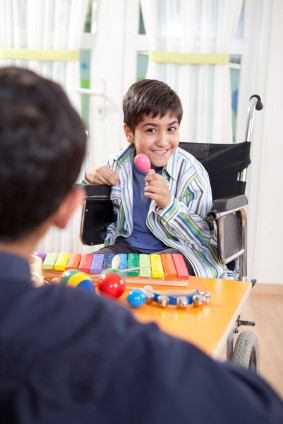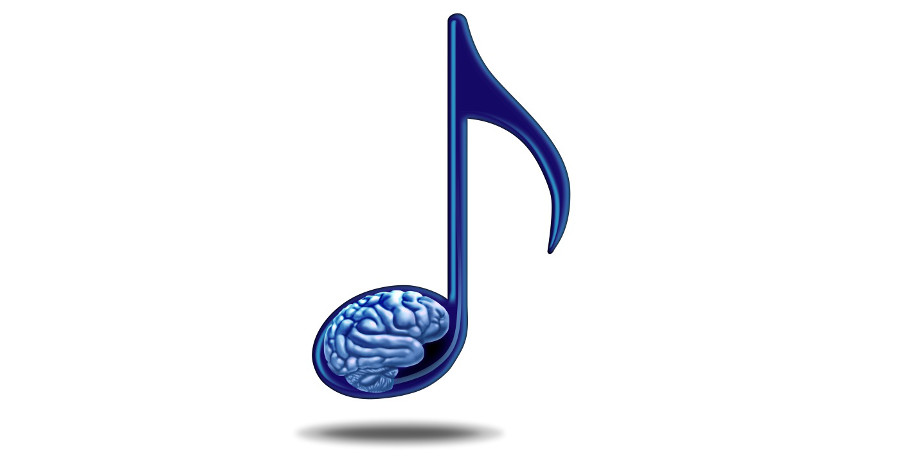Most of us enjoy listening to music, but did you realise it can be used to help people with disability, illness and injury. Music therapy can transform lives.
For many of us music can be the soundtrack to our life. We associate music with events, people, places – happy songs, sad songs, songs with lyrics that we relate to, classical arias that lift our spirit.
Music can change our mood – can make us smile when we are down, laugh when we might otherwise cry.
Music has a positive effect.
Music can soothe your soul.
Music gives us a way to express emotion.
For some people, it can give a lot more.
[divider]
Bono:
Music can change the world because it can change people.
What is music therapy?
Music therapists can help children and adults communicate using music as the medium.
 Music therapy is a recognized profession that is used in some health services, e.g. the UK and US. Most music therapists are musicians first who then take a postgraduate diploma in music therapy.
Music therapy is a recognized profession that is used in some health services, e.g. the UK and US. Most music therapists are musicians first who then take a postgraduate diploma in music therapy.
Music therapy uses music to form a relationship between the therapist and the individual using rhythm, melody and tone, accessible instruments and voice.
How music therapy is used will depend on the individual, their reaction to music and their abilities. Some will want to sing, others play an instrument; some may want to compose music. The foundation to music therapy is that everyone responds to sound and this can lead to positive changes in behavior and emotional wellbeing.
Listening to music and playing music is different for everyone, just think of the deaf percussionist Evelyn Glennie who ‘feels’ her music.
Here’s a little taster of what music therapy has done for some children.
Nordoff Robbins is a Music Therapy Foundation in the UK. They are known for their work with patients who have autism, though this is only one condition they work with – this is one of their introductory videos.
Sing, Gary Barlow:
There’s a place, there’s a time in this life when you sing what you are feeling.
When can music therapy help?
Music therapy can help people of all ages with a wide range of conditions including autism, cerebral palsy, learning difficulties, dementia, cancer, trauma and mental illness. Primarily it has been shown to help people who have difficulty with communication.
Brand New Me, Alicia Keys:
It took a long, long road to get here, It took a brave, brave girl to try.
Music Therapy and Autism
On September 11 Beatrice Gollini wrote a blog post about autism – which is one of the conditions that can be helped with music therapy. If you want to learn more about autism, read her blog post.
Nordoff Robbins is a music therapy charity in the UK which has worked with autistic children since the 1950s. They have shown that music therapy can help with:
- Communication – in all forms including speaking
- Movement – helping coordination
- Social development – joining in, instead of being outside
- Emotional development – expressing emotions
- Cognitive development – helping learning
- Early intervention – enhancing development at an early age
Other studies confirm this. In a study of 41 children with autism who received one hour of music therapy a week improvements were seen in inattentive behaviour over a ten month period.1
Taking part is often difficult for people with autism. Conductor John Lubbock spends many days with selected musicians from his orchestra playing for children with autism at special schools. A bit of a change from the Carnegie Hall in New York or the Royal Albert Hall in London, but the musicians are just as serious about the pieces they play and they have a very receptive audience.
Lubbock has a natural empathy with the children. Even though some carers are sure the children won’t go up to conduct (typically children with autism shy away from social contact), the majority of the children accept his invitation. ‘Some people can be very tense if they’re not used to disability,’ he says, ‘and the children pick up on that instantly. But I’m not scared of these children; I have one at home.’ Lubbock has a son with autism.2
Roar, Katy Perry:
I went from zero, to my own hero.
Music therapy and cerebral palsy
Children with cerebral palsy often have little control over their body – they may want to move in time with music, hold on to instruments, but doing it is very difficult. They are often very aware of the world around them, yet unable to react to it as they wish, or be able to speak and say what they want to do.
Positioning instruments close to children or even taping instruments such as maracas to their hands can enable them to take part in music and communicate.3
Developing a sense of rhythm can help control body movements, help coordination and enable those with cerebral palsy to use their limbs in a fun, artistic way.
The rhythmic aspects of music provide a structure that can help people learn to walk, communicate verbally and enjoy life.
Music and cerebral palsy both affect multiple areas of the brain. Cerebral palsy affects motor skills and is often accompanied by problems with communication, perception, sensation and behaviour – which may arise from different parts of the brain.
Music can form a bridge, as seen in the emerging field of Neurologic Music Therapy. The brain can grow and change in response to stimuli, such as music. Music has been shown to grow neural pathways in the brain by linking the areas dedicated to sound, touch, movement, speech (in the case of singing), and emotion – all areas involved in making music.
Search for the hero, M People:
You’ve got to search for the hero inside yourself. Search for the secrets you hide.
Music and the NDF
At the recent Friendship Games organised by NDF the children were singing and enjoying music – helping them to enjoy their time together. Music is central to our ability to communicate with one another.
You’re my best friend, Queen:
You’re the best friend that I ever had.
The influence of music
The following musical reminder may make you think of a person, a place, a dance – I am sure it will make you smile”¦.. see what a difference music can make!
Get Lucky, Daft Punk:
We’ve come too far to give up who we are.
If you would like to learn more about music therapy
There are associations for music therapy around the world – I have listed some of them at the end of this blog.
If you live in Serbia there is a monthly lecture in Belgrade – see the link to the site and you can contact them for details.
The following video shows how music therapy has helped politician Gabrielle Giffords in the US to recover from a brain injury and it shows how music therapy can help children going through cancer therapy. Do watch it through to the end – see what a high five can mean to a child.
Links to Music Therapy Associations
These are just some of the music therapy associations around the world.
The British Association for Music Therapy
American Music Therapy Association
European Music Therapy Confederation
World Federation of Music Therapy
The Australian Music Therapy Association
The Association of Music Therapists Serbia
You can also download an international index of music therapy organisations from the Nordoff Robbins website – see www.nordoff-robbins.org.uk
References
1 www.sciencedaily.com/releases/2013/02/130219140100.htm
2 www.telegraph.co.uk/culture/music/10046513/Music-releases-autistic-children-from-their-chains.html
3 www.midtnmusic.com/cerebral-palsy-symptoms-improved-by-music-therapy/

















